Their homes were destroyed on Oct. 7 — these drawings recapture the life that was
Artist Noa Harnik is using art to preserve memories of life before a massacre
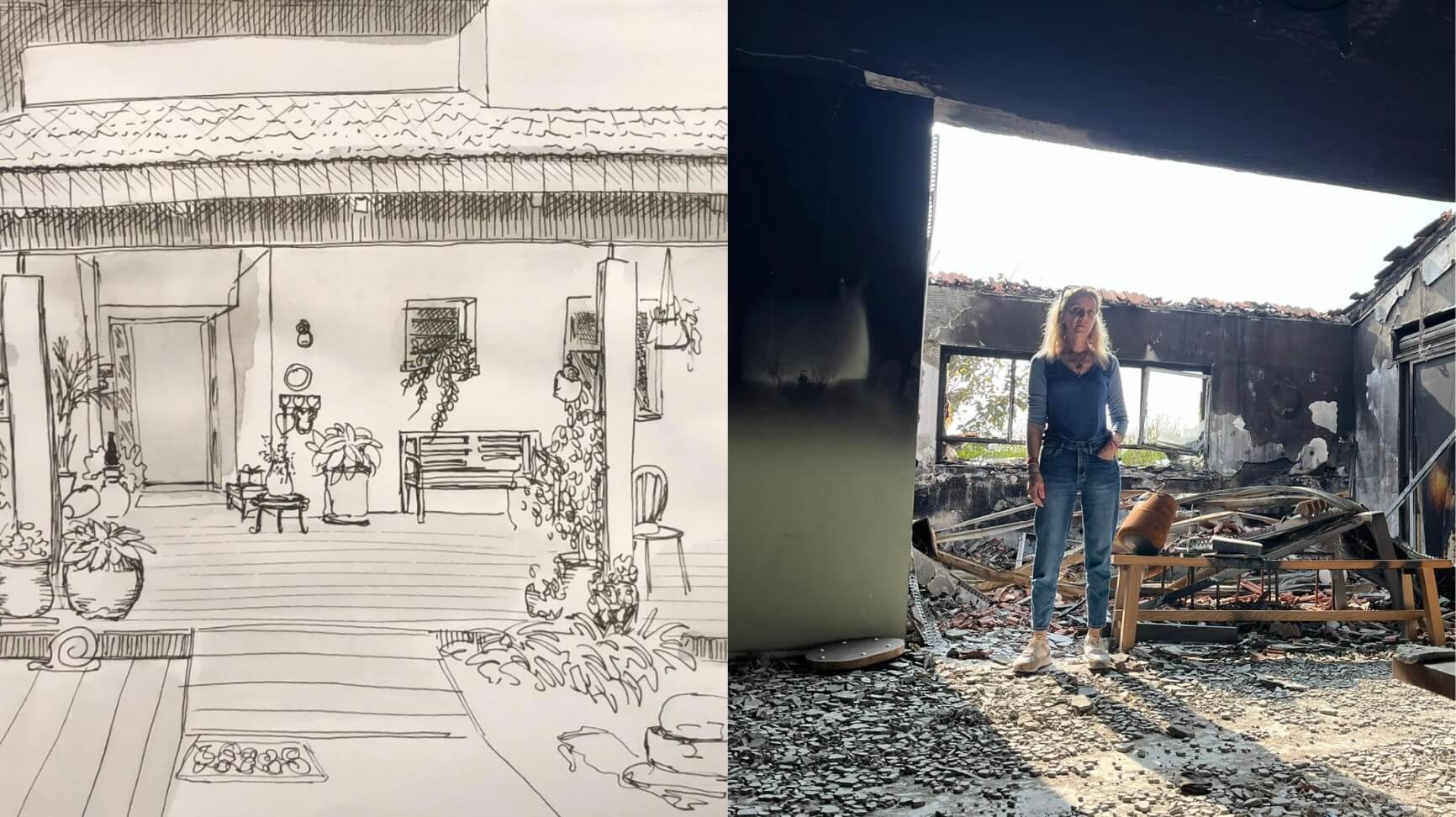
Screenshot Courtesy of Sharon Segev
Before Oct. 7, Sharon Segev’s house had a thriving garden. A stone path flanked with vibrant greens ran alongside a cozy porch. She loved sitting outside to watch the sun set, seeing flowers bloom, walking through fields nearby, and picking lemons. She and her family and the tight-knit community of Be’eri cherished traditions. As was tradition, they spent the evening of Oct. 6 together, celebrating the kibbutz’s birthday with songs and stories.
On Oct. 7, Sharon hid in the house’s safe room with her husband Doron and their three teenaged children. Hamas terrorists entered the house and tried to get into the room, unsuccessfully attempting to force the door and exploding a small hole in the reinforced window. Then, they set the house on fire, engulfing the family in heat and smoke. Segev’s son, the oldest of the kids, asked multiple times if he could jump out the window, but they said no. Finally, he didn’t ask. He opened the window and jumped out. They didn’t close it after him, desperate for some air to breathe and praying the terrorists wouldn’t return to find the opening. Their son hid in the bushes for hours. When the rescuers arrived, he directed them to the window. Their neighbors had been murdered, but miraculously, all five members of the Segev family made it through the day.
Long before Oct. 7, Sharon, a special education teacher and art lover from Hatzerim, and Doron, a former architect and Be’eri native, had designed their home together. It was clean and well-kept, dotted with plants and full of art. You could sit on a long bench at the kitchen table and peer at the sky through broad windows and sliding glass doors.
“That was the life of before,” Segev told me over the phone, speaking in Hebrew. “We lived in a beautiful house that we loved.”
“We were very very connected to the home and to the neighbors,” she added. “We felt very safe.”
After Oct. 7, that sense of safety evaporated. All that remained of the house were charred walls and crumbling rooms full of debris of life before — and drawings from a stranger that captured the lost home in meticulous detail.
‘How can I help someone? You just want to help someone.’
Noa Harnik started drawing again in January 2021 during Israel’s third COVID lockdown, a childhood hobby reclaimed to ward off the depressive pull of the pandemic. A former first assistant director who’d left the film industry and started her own professional home organizing and moving business, Harnik took some classes and began drawing what she saw around her. A messy corner strewn with her daughter’s shoes and ukulele. Her kids’ old preschool. The streets she walked and the cafés she frequented.
A Jerusalem transplant to Tel Aviv, Harnik has a deep love for her adopted city of more than 30 years. Capturing its nooks and crannies felt meditative. Her drawings became a kind of “journal of my life, where I went and what I did,” Harnik told me over Zoom from her home in Tel Aviv, speaking in Hebrew.
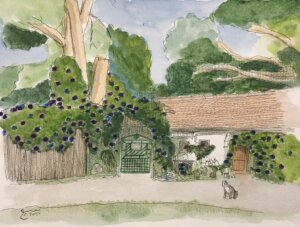
One day, someone glimpsed what Harnik had sketched while she waited for her husband outside of a doctor’s office. They wanted to buy it, they told her. “You’re exaggerating, what do you mean buy it? Just take it,” she remembered saying. Too stunned to imagine charging anyone for a drawing, she gave it to them as a gift.
Eventually, though, it became an extra source of income. When she wasn’t helping people pack or organize their houses, she was capturing homes in commissioned illustrations. A grandmother’s childhood home in 1930s Berlin. A mother’s beloved mirpeset, or terrace, in an apartment she left behind. The building where a couple met.
“Then there was war, like the sky fell,” like “a horrible hallucination,” Harnik said. “It was like walking in a bubble or like you see in apocalyptic movies where the world is decimated and you walk and everything is empty,” she said. “Now, it wasn’t empty, but people were so within themselves and in shock.”
On the morning of Oct. 8, even though the world felt frozen and fragile, she had to go to work. She was scheduled to help someone pack for a move. “It was scary,” she said. “You don’t know what’s happening.” Being busy helped. And when she and her assistant got back to Tel Aviv, they parked the car and jumped right in to join a popup volunteer operation preparing meals for soldiers and displaced families.
“We got there, went inside, went down to the basement, and started cutting onions,” she recalled. For some, the task gave them an excuse to cry. “We basically lived there for two weeks.”
In some ways, Tel Aviv is a distant, different world than Be’eri and the other towns and kibbutzim of the Gaza Envelope. But they’re barely 100 kilometers apart. “I’m part of this thing that happened an hour away from my home — not in the U.S. or Ukraine — it’s right here and I’m part of it but I’m not part of it,” Harnik said. “You feel a little guilty that it happened to them and not to you,” she said. But also relieved, she said. And then maybe guilty again.
Harnik’s instinct was, “How can I help someone? You just want to help someone.” If she didn’t do something, she said, she felt she might go crazy. So she went back to drawing homes.
‘Home is part of the soul’
A few weeks after the attacks, Harnik posted on Facebook. In the space where she typically shared sketches of Tel Aviv architecture that strike her fancy, she made an offer.
“I don’t know how many photos remain, and I don’t know when there will be walls to hang drawings on,” she wrote in Hebrew. “But if you’re from the western Negev and your home was destroyed on Oct. 7 — and you can get me pictures of the house before, doesn’t matter if it’s inside or outside, whatever best expresses the home for you — I’d be more than happy, and in fact it would be my honor, to draw it for you as a gift.”
Pretty quickly, the requests began arriving through Facebook, Instagram, and email, about homes in Be’eri, Nir Oz, Kfar Aza, and other communities devastated on Oct. 7. Some requests came with stories of lost family members, neighbors, homes, daily routines, and security.
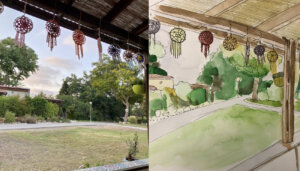
It was sometimes a struggle for people to find photos of their homes from before. “You never think you need to take a picture of your house until you don’t have it,” Harnik said. On the other hand, she added, you can’t live your life trying to capture everything because it might disappear tomorrow.
In the case of the Segevs, everything had burned. They had new phones with fresh camera rolls. Sharon Segev scrounged up images from friends and family members and shared what she had. “From what I sent her, she created a memory for me,” Segev said. Or two, rather.
In one drawing, Harnik captured the front door, every window and shingle and potted plant in place. In another, she depicted the corner of the living room behind the stairs, complete with miniature recreations of the art on the walls and stacks of cushions by the armchair and pillows on the sofa. Segev was moved by the details.
“I cried like I’ve been crying for 10 months,” Segev said. “It’s not just a drawing. It has soul. It’s like my life in this home. She got the smallest things right,” she said. “In her drawing she made me feel — for a moment, I remembered all the memories and the life that happened there.”
Harnik lost count of the number of requests, chipping away in the order they came in. She sketched a house in Holit surrounded by trees, their trunks casting geometric shadows on the grass. She drew the view from a porch in Kfar Aza, a row of what look like colorful dream catchers dangling along the top. She captured the vibrant facade of a home in Be’eri, a bright yellow decorative bicycle parked out front and a blue and white flag flapping in the wind.
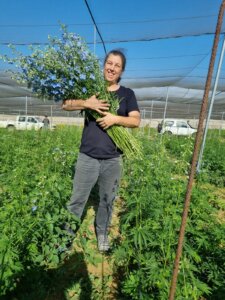
And she drew the front gate — surrounded by voluptuous green leaves and bright purple flowers — of her friend Adi Negev’s home in Nir Oz, one of only a handful Hamas didn’t enter on Oct. 7. An old friend and colleague from their days in the film industry, Negev reached out and asked if Harnik would draw her home even though it wasn’t destroyed.
Negev didn’t evacuate with her remaining neighbors after the attacks, in part because it was her job to feed the kibbutz cats. “The cats need me. So I stayed,” she told me. “Nir Oz needs me.”
Alone in the empty kibbutz, which she described as a “kind of heaven” pre-Oct. 7, with only cats and soldiers, Negev looked to art for solace. And Harnik’s drawing of her home, she said, was the “perfect gift.”
“Home is part of the soul,” Negev said. “I need my home to be in my center. And after Oct. 7, it’s even more important.” She cried when Harnik gave it to her, and then quickly framed it and hung it beside her TV.
“I really love this picture,” she said. And looking at it every day, she said, makes her feel “like I’m loved.”
‘I gave it with love’
Harnik’s isn’t the only project that’s focused on homes in the wake of tragedy and loss. In the summer of 2020, Meg Adler, a Jewish educator, artist, and poet in the Bay Area, put out a similar offer to memorialize homes lost to California wildfires.
“This won’t fix the tremendous loss,” she wrote in an Instagram post, but “it will hopefully allow folks to mourn and honor their memories.” She liked to look at buildings as characters in people’s lives. “We have commitments to buildings. We see buildings and we feel things and we feel connected to them,” she told me in 2021. “I think it matters what the house used to look like. It’s a way to grieve.”
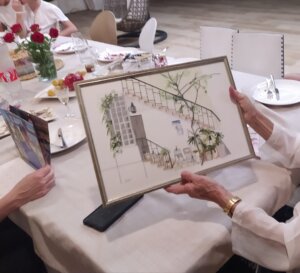
From the start, Adler welcomed the notion that other artists might take up the mantle in their communities. “It’s just an idea that I’m doing. Anyone can do it,” she said. “Like when Hurricane Ida came through, if some artist in New Orleans wants to draw houses destroyed by Ida, I think someone should be doing that.”
Halfway around the world, Harnik posted her own call, having never heard about Adler’s drawings. But their instincts were similar — to do whatever they could with the skills they had.
“For me, it was like medicine,” Harnik said. At a time when she was overwhelmed with helplessness, “I felt like I was doing the smallest or most idiotic thing, but I was doing something for someone and maybe helping.”
At one point someone suggested to Harnik that she should turn her illustrations into a book. But for the most part, she didn’t have them anymore. She occasionally snapped pictures with her phone to keep track of which drawing was for who, but she’d made each one and gifted it as soon as she could get it to the right person. And that feels right to her.
“It’s theirs. They’ll decide when and what they want to do with it,” Harnik said. “I gave it with love”
‘We imagine the home we’ll have’
Segev doesn’t know yet where the drawings she received will live in the long run.
“In some ways, we’re still on Oct. 7,” she said. “We’re still there. We still remember those moments, still breathe the smells, still remember the fear. Sometimes we still have nightmares. In a lot of moments in the day we’re still there.”
For nearly a year since the attacks, they lived in a hotel at the Dead Sea with other families from Be’eri. “In addition to dealing with pain and loss, we’re also dealing with how to make a family in a hotel,” she said. “I don’t always feel like we succeed.” With the anniversary of Oct. 7 approaching, they moved into a temporary unit in Hatzerim, which is taking in members of the Be’eri community until they can return to more permanent homes.
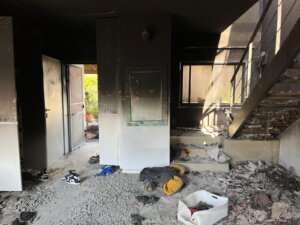
Each family member is processing and coping in their own way. As a hydrotherapist, Doron has been treating soldiers coming out of Gaza and has found the work therapeutic. As for Segev,“I’m healing myself through a podcast I started.” Just as Harnik harnessed her drawing skills as a tool to navigate the post-Oct. 7 world, she said, “my tool is listening and talking.” The podcast is aptly called Bereshit “because I’m recreating myself,” she said. “I made myself a home.”
Segev’s youngest daughter, who is 13, has been too scared to go back to visit Be’eri, but the rest of the family has. Segev’s oldest son, who is 18, has even moved into a room there while he waits to join the army.
“My heart expands when I enter Be’eri because it’s my home,” Segev said. “The first time I broke down. It was so hard for me. I understood the extent to which I had nothing left.” It was acutely painful to see the rubble, but helped her realize and accept that “what I had won’t be back,” she said. “We let go. We let go of the home itself. The memories are harder to let go of.”
With an ongoing war, hostages still in Gaza, and each family member continuing to heal at their own pace, it’s too soon to say what their next steps will be. “But yes we imagine the home we’ll have,” Segev said. “It gives us a lot of strength to think we will have a home.”
One thing she can say with confidence is that their future home will include art. “My home was all works of art,” she said. Both home and art were destroyed on Oct. 7, but now she said she has the first drawings of what will become a new collection. They’ll frame Harnik’s drawings and hang them up when they settle into their new home one day. “It’s both art and a reminder of the life that was.”
















